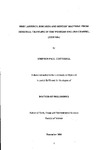Fish landings, discards and benthic material from demersal trawling in the western English Channel (ICES VIIe)
| dc.contributor.author | Cotterell, Stephen Paul | |
| dc.contributor.other | School of Geography, Earth and Environmental Sciences | en_US |
| dc.date.accessioned | 2013-11-19T11:45:22Z | |
| dc.date.available | 2013-11-19T11:45:22Z | |
| dc.date.issued | 2006 | |
| dc.identifier | NOT AVAILABLE | en_US |
| dc.identifier.citation |
Cotterell, S.P. (2006). Fish landinds, discards and invertebrate material from demersal trawling in the western English Channel (ICES VIIe). PhD Thesis, University of Plymouth. | |
| dc.identifier.uri | http://hdl.handle.net/10026.1/2751 | |
| dc.description | Merged with duplicate record 10026.1/600 on 07.20.2017 by CS (TIS) | |
| dc.description.abstract |
This study examined the impact of inshore single boat otter trawling from Newlyn, Looe, Plymouth and Salcombe and pair boat demersal trawling from Looe and Plymouth on the benthic environment off the SW peninsula of the UK between 1998 and 2000. Fish and shellfish species (54 and 11 species respectively) were measured at sea and the non-fish material (124 species) was analysed later. Overall 79.8% of the sample was landed fish and shellfish, 15.8 % was discarded fishes and 4.4 % was invertebrates and other material (by weight). Related information about the substrate and tide were generated from British Geological Survey data and a computer simulation of the maximum mean tidal strength. In agreement with the different abiotic regime, the dominant fishes were different in Newlyn and the other ports. According only to port, the Looe and Plymouth samples were not significantly different, either as full samples or for their fish and non-fish components. The Salcombe samples were not significantly different to those from Looe or Plymouth for the non-fish part of the sample. Including the type of trawling meant that the greatest similarity was for the non-fish part of the sample although the relative amounts of the components varied. The pair trawling samples contained more landed, less discarded and less non-fish material than their single boat equivalents. Pair trawl samples also contained fewer examples of large invertebrate species. Several within and between-species relationships were explored to assess the wider interpretation of the fish community data. This examined size of Raja spp., several predator-prey relationships and the utility of Marthasterias glacialis as an indicator of fishing disturbance. Disturbance as measured by Abundance Biomass Comparison was similar whether according to the non-fish or full sample, and suggested that the whole region was relatively undisturbed (with Newlyn apparently the most impacted area). Analysis of the relative contribution of selected groups to taxonomic diversity showed the derived conservation priorities for 'orders' of fishes were Elasmobranches > Pleuronectiformes > Gadiformes. In general, the fact of 'losing' orders of fishes was more important for single rather than pair trawl samples, which suggests that single boat samples were collected from structurally more complex areas supporting a wider taxonomic diversity. The analysis of groups for conservation priority was also carried into the invertebrates with echinoderms being highly influential for Newlyn. Taxonomic diversity (∆ + and Λ + )was also proposed as an addition to the definition of 'Good Environmental Status' according to the proposed EU Marine Strategy Directive. When examining the abiotic and biotic data sets, the fish species bore the closest similarity to the abiotic data suggesting that much of the study area was dominated by similar invertebrate species that tended to be scavengers and in most analyses the positive influence of the voluntary Inshore Potting Agreement management regime was evident. In a novel analysis, there was broad agreement between the data and literature sources for the location of the fishes in relation to the substrates and for eight of the most commonly occurring species it was possible to be more precise in their substrate preferences than suggested from the literature. The landed fish part of the sample was shown to be a statistically good approximation of the landed part of the haul (for which the commercial data was known) in > 95 % of the hauls. Finally, data on the commercial landings for each port show that the boats sampled in this study were representative of these ports. | en_US |
| dc.description.sponsorship | Plymouth Environmental Research Council; School of Earth, Ocean and Enviromental Sciences; Faculty of Science | |
| dc.language.iso | en | en_US |
| dc.publisher | University of Plymouth | en_US |
| dc.subject | taxonomic distinctness | |
| dc.subject | English Channel | |
| dc.subject | disturbance | |
| dc.subject | demersal trawling | |
| dc.subject | by-catch | |
| dc.subject | discards | |
| dc.subject | fisheries | |
| dc.subject | trawl sampling | |
| dc.title | Fish landings, discards and benthic material from demersal trawling in the western English Channel (ICES VIIe) | en_US |
| dc.type | Thesis | |
| plymouth.version | Full version | en_US |
| dc.identifier.doi | http://dx.doi.org/10.24382/1450 | |
| dc.identifier.doi | http://dx.doi.org/10.24382/1450 |
Files in this item
This item appears in the following Collection(s)
-
01 Research Theses Main Collection
Research Theses Main


